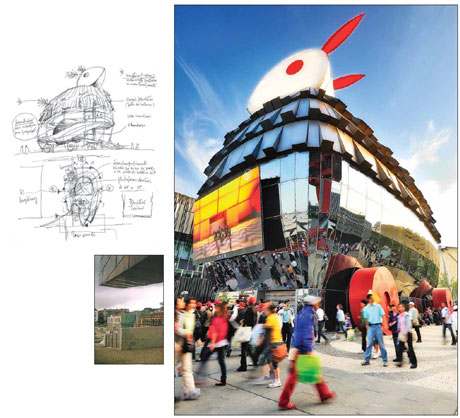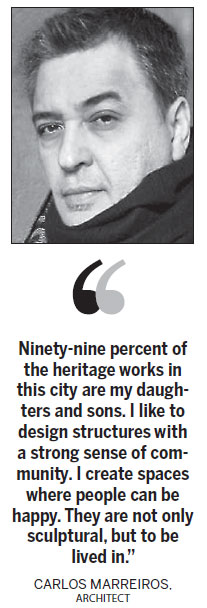
 |
|
Clockwise from right: Little Rabbit Pavilion, the Macao SAR Pavilion at the Shanghai World Expo, designed by Carlos Marreiros. Tap Seac is one of Marreiros' projects in Macao. Preliminary sketches by Carlos Marreiros in 2008. Photos by Gabriele Masera for China Daily |

One of Macao's most outspoken voices on cultural identity, architect Carlos Marreiros considers all of his projects like his own children, Rebecca Lo finds.
In the shade of ancient trees, the genteel ochre-colored exterior of architect Carlos Marreiros' studio is a blast from the past that's somewhat incongruous amid the glitzy skyscrapers of modern Macao. After being shown to a boardroom with lofty ceilings and a central table piled high with exhibition brochures and design books, I am served coffee in tiny espresso cups with sugar on the side. No milk. A few minutes later, an imposing gentleman dressed in jeans and black jacket strolls in, shakes my hand and ushers me over to the opposite side of the room. "Let's sit here," says Marreiros, settling near an open window while offering me a cigarette from his pack of Marlboros. "I'm smoking." Amused and a tad nonplussed by his seamless combination of gracious host and political incorrectness, I decline. Carlos Albertos dos Santos Marreiros has never shied away from doing things his way.
Born in 1957, he is a poster child for the cultural melting pot that is Macao. On his father's side, he is descended from Spaniards who settled in Portugal in the early 17th century. His mother is Eurasian, with a father from the Santos family - one of the oldest names in Macao - and a Chinese mother descended from Zhongshan.
"I was educated to respect Chinese and Western cultures," recalls Marreiros. "When I was young, my father used to show me around Macao's heritage buildings - not only the churches but also the Chinese temples."
It was natural that he pursued a career in architecture. He obtained his master's degree at the Technical University of Lisbon, followed by an internship in Germany and additional studies in Sweden.
Upon his return to Macao, Marreiros concentrated on urban-renewal projects. He currently runs one of the largest architectural firms in Macao, working on private and public buildings in Macao, Hong Kong and the Chinese mainland.
One of his earliest projects was the revitalization of Senado Square 30 years ago. His work is contemporary and sometimes cutting edge, although if he is working with a historic structure, he will respect its heritage and not try to force it to become something it isn't.
"Ninety-nine percent of the heritage works in this city are my daughters and sons," Marreiros says. "I like to design structures with a strong sense of community. I create spaces where people can be happy. They are not only sculptural, but to be lived in."
In 2004, Marreiros discovered a set of buildings affectionately known as the Albergue or Old Ladies House owned by the Holy House of Mercy in the St. Lazarus district when they were almost in ruins.
He set about to adapt them into his studio and to foster a cultural environment for events, exhibitions and like-minded businesses in the pursuit of Macao's evolving cultural identity.
"I envision the Albergue as a place for cultural activities, where people are trained to pursue creativity. It is food for the spirit. Businesses that set up shop here must suit that purpose. For example: no Thai massage parlours!"
Today, along with Marreiros' office, the Albergue is home to fashion and industrial design studio Lines Lab, restaurant Albergue 1601 and a new Portuguese shop called Mercearia.
Through Marreiros' role as director general of Albergue SCM, the site hosts an ambitious cultural program with support from both public and private funds.
In the past, events have included fashion shows, art exhibitions, workshops, talks - even a Pecha Kucha night as part of the biannual event This is My City.
"I suggested for the Albergue to be included in the listings for the UNESCO World Heritage sites," says Marreiros. "It will happen in 10 or 15 years. My late partner Francisco Figueira and I believed that Macao's historic center would be classified with World Heritage status 20 years ago. At the time, we were called romantics. And egomaniacs."
Nearby Tap Seac was another of Marreiros' projects that spanned a period of decades. Beginning with the restoration of buildings along Avenida do Conselheiro Ferreira de Almeida, the entire block was revitalized.
He diverted traffic, turned a former sports arena into an open European-style square and hid all of the services underneath it.
"It is the biggest square in Macao and one of the biggest squares in Asia," Marreiros says. "The public buildings were designed for interaction, and the square was designed for locals to organize activities."
He looked back to the days of Macao's past for his design of the Macao SAR Pavilion at the Shanghai World Expo in 2010. A winner in a public competition, his rabbit lantern is reminiscent of a gentler time in Macao's past.
"I played with these lanterns when I was young," he remembers fondly. "It was the only public building since 1999 that did not receive any negative public criticism in Macao."
He credits his father with being a multifaceted man who played in an orchestra, loved to draw and a "hero".
Marreiros himself is also interested in many diverse things: He writes poetry, teaches at universities and draws. Late last year, some of his sketches were exhibited in Beijing's 798 Art District in the AFA gallery.
He is president of the Fellow Members Council of the Architect Association of Macao and serves on the Macao Government Cultural Advisory Committee.
In addition, he is a chef by inclination and founded O Porto Interior Restaurante in 1995 as a place to welcome friends and family with home cooking.
The name O Porto Interior, which means inner harbor, is a nod to the nearby pier that greeted visitors for centuries before the ferry terminal moved to the outer harbor.
It is also a wink at Marreiros' profession, as the interiors are decorated with art and artifacts from his personal collection of filigree-like bamboo birdcages and Chinese porcelain.
"I'm called a Renaissance man," Marreiros states with a smile.
Contact the writer at sundayed@chinadaily.com.cn.